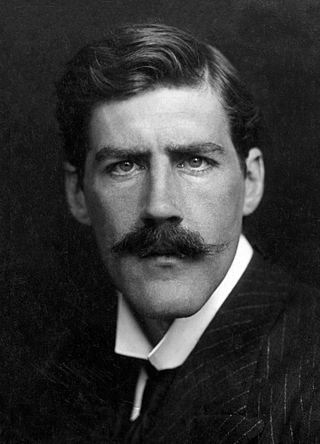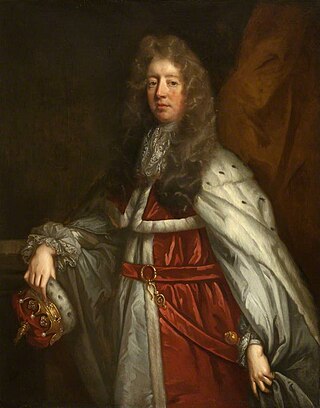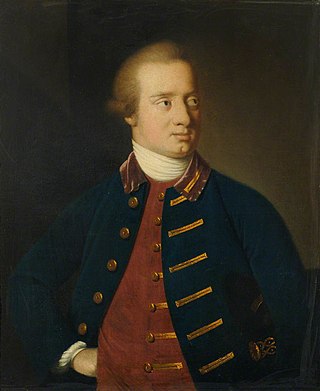Related Research Articles

David Alexander Edward Lindsay, 27th Earl of Crawford and 10th Earl of Balcarres,, styled Lord Balcarres or Lord Balniel between 1880 and 1913, was a British Conservative politician and art connoisseur.

David Boyle, 7th Earl of Glasgow,, was a British naval commander and colonial governor. He served as Governor of New Zealand between 1892 and 1897.

General Alexander Lindsay, 6th Earl of Balcarres, 23rd Earl of Crawford, styled Lord Balniel until 1768, was a Scottish nobleman, soldier, politician and colonial administrator.
Vice-Admiral Keith Stewart was a Scottish Royal Navy officer and politician who sat in the House of Commons on two occasions. Having begun his naval career in around 1753, Stewart was promoted to commander in 1761 and then advanced to post-captain in 1762 because of political negotiations undergone by his father Alexander Stewart, 6th Earl of Galloway. Stewart commanded HMS Berwick at the Battle of Ushant in 1778 and in 1781 was appointed Commander-in-Chief, North Sea only to be superseded by Hyde Parker soon afterwards. As such he served at the Battle of Dogger Bank as a volunteer on Berwick.
William Ker, 2nd Earl of Roxburghe PC was a Scottish nobleman who inherited his title from his maternal grandfather, Robert Ker, 1st Earl of Roxburghe.

John Montagu, 5th Earl of Sandwich, PC, styled Viscount Hinchingbrooke until 1792, was a British peer and Tory politician.

Captain Archibald Kennedy, 11th Earl of Cassilis was a Scottish peer who lived in the English colony of New York which became part of the United States.

Henry Herbert, 10th Earl of Pembroke was a British Army officer, peer, politician and courtier who served as a Lord of the Bedchamber to King George III in 1769. He was renowned for his skill in horse training. Captain James Cook's famous ship, HMS Endeavour, was formerly MS Earl of Pembroke, launched in 1765 and named after the 10th Earl.

Admiral Sir Frederick Hew George Dalrymple-Hamilton KCB was a British naval officer who served in World War I and World War II. He was captain of HMS Rodney when it engaged the Bismarck on 27 May 1941.

Rear Admiral Sir John Lindsay, was a British naval officer of the 18th century, who achieved the rank of admiral late in his career. Joining the Navy during the Seven Years' War, he served off France, followed by service for several years as captain of a warship stationed in the West Indies. After war's end, he returned to Britain, serving as an MP for Aberdeen Burghs from 1767 to 1768. From August 1769 to March 1772 Lindsay was promoted to commodore and assigned as commander-in-chief of the East Indies Station. He resigned from the Navy for a period following the Battle of Ushant (1778) off the coast of France, during the American War of Independence. In 1784 he was assigned as commodore and commander-in-chief in the Mediterranean. In the last year of his life, he was promoted to rear admiral as an honorary position, as his failing health prevented him from taking a command.

Colin Lindsay, 3rd Earl of Balcarres (1652–1722) was a Scottish aristocrat and politician, and one of the most important supporters of James VII of Scotland& II of England and Ireland in Scotland.

Sir Coutts Lindsay, 2nd Baronet, was a British artist and watercolourist.
Alexander William Crawford Lindsay, 25th Earl of Crawford, 8th Earl of Balcarres, styled Lord Lindsay between 1825 and 1869, was a Scottish peer, art historian and collector.

James Lindsay, 24th Earl of Crawford was a Scottish peer, politician and military officer.
Alexander Lindsay, 4th Earl of Balcarres (died 25 July 1736) was a Scottish peer.

Captain Robert Boyle-Walsingham was an Anglo-Irish Royal Navy officer and politician. He was killed in the Great Hurricane of 1780 while serving as a commodore onboard HMS Thunderer.
Charles Dalrymple Lindsay, was Bishop of Killaloe and Kilfenora from 1803 to 1804 when he was translated to Kildare.

Robert Fanshawe was a British officer of the Royal Navy and a Member of Parliament.
Vice-Admiral the Hon. Charles Orlando Bridgeman was a Royal Navy officer who saw active service in the Napoleonic Wars and the Greek War of Independence.
Robert Lindsay, 9th Lord Lindsay PC, was a Scottish landowner.
References
- ↑ Harrison (2019), p. 313.
- ↑ "Lady Anne Lindsay". Clan Lindsay. Archived from the original on 24 May 2013. Retrieved 17 May 2014.
- ↑ Augustus Hare, The Story of My Life, Volume IV (George Allen, London, 1900), at page 137